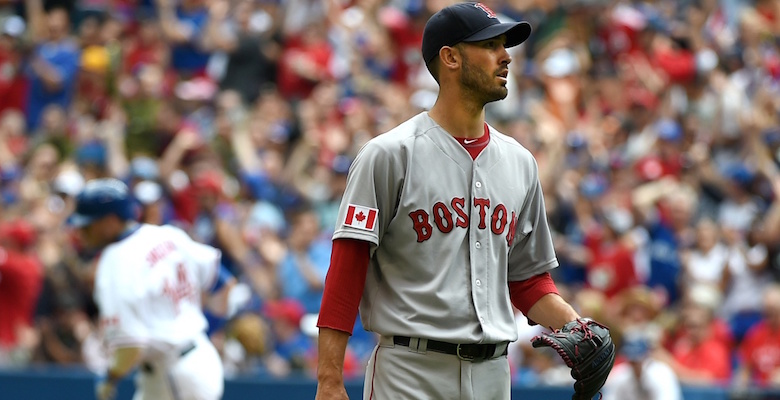A lot went wrong for the Red Sox in 2015, and Rick Porcello’s performance in a new uniform was no exception. The right-hander’s season was one heck of a rollercoaster ride, even if Boston fans and Porcello himself likely didn’t have much fun.
Now that we have the luxury of looking back on his entire first campaign in Boston, there are two ways in which we can view Porcello’s campaign. On one hand, his initial season with the Red Sox was a borderline disaster, and the fact he’s entering the first year of a four-year, $82.5 million contract in 2016 raises serious cause for concern.
On the other hand, one can view Porcello’s 2015 as a year in which he made some key adjustments after determining the reasons for his first-half struggles. The Porcello who pitched down the stretch for Boston, in other words, looked like the starter the Red Sox imagined they were trading for last winter.
No matter which theory you subscribe to, the alterations Porcello made to his approach over his final nine starts leave some room for cautious optimism.
Porcello’s performances over the first three months of 2015 were abysmal, in part, because he went away from what had made him successful in Detroit. As many have documented, the righty leaned on his four-seam fastball far more frequently and began pitching up in the zone in search of extra strikeouts. While Porcello garnered more whiffs, he also gave up harder contact. The sinker that had made him one of baseball’s best groundball pitchers with the Tigers was suddenly far less of a factor in his arsenal.
A Rick Porcello who keeps the ball on the ground with frequency, picks up his fair share of strikeouts and doesn’t surrender free passes is just the type of pitcher that Boston felt comfortable handing a four-year extension to last April.
Upon his return from the DL in late August, Porcello recommitted to his sinker. He threw the offering 49 percent of the time over his final nine outings compared to a usage of 34 percent prior to that. His four-seamer usage, in turn, dropped from 31 percent back down to 18 percent after he returned from injury.
Porcello’s numbers from that point forward are hard to argue with, even if they came over a sample of just 57.1 innings. The 26-year-old posted a 3.14 ERA and 2.85 FIP, striking out 57 batters and walking just 11. That 5.2 strikeout-to-walk ratio would stand as the highest of Porcello’s career by quite some margin if translated to a full season.
Even more encouraging, however, was Porcello’s renewed ability to generate ground balls. After posting groundball rates greater than 50 percent in five of his first six seasons, Porcello yielded grounders just 45 percent of the time prior to landing on the DL. Upon returning, his groundball rate rose to 51 percent over that final nine-start span, which is right in line with his career average.
A Rick Porcello who keeps the ball on the ground with frequency, picks up his fair share of strikeouts and doesn’t surrender free passes is just the type of pitcher that Boston felt comfortable handing a four-year extension to last April.
Yet how sure can the Red Sox be that Porcello’s improvements down the stretch are legitimate? How much credit for his stellar performances should be given to the adjustments he made? And, most importantly, how sustainable are his strong numbers going to be over a larger time span?
These are the questions Porcello will be facing heading into 2016, and they can’t be easily answered until he takes the mound again. That he’s never pitched as poorly as he did for long stretches this past year gives us, in a way, cause for hope. Still, we shouldn’t necessarily expect Porcello to post a sub-3.00 FIP over a larger sample like he did in August and September.
Although he made clear changes to his approach and enjoyed improved results, Porcello still has his fair share of limitations. Even during his best sinker-balling days in Detroit, Porcello was susceptible to giving up home runs, an issue that cropped up repeatedly this season. And despite his attempts to garner more whiffs, he’s also a pitcher who allows plenty of balls in play and depends heavily on the defense behind him. Given that Pablo Sandoval and Hanley Ramirez are both slated to start in Boston’s infield next season, that could bode poorly for Porcello.
With all the tinkering he did during the season, how good Porcello can truly be is still shrouded in uncertainty. In many ways, we know hardly anymore about him than we did back in early April, when BP Boston chief Ben Carsley characterized his extension as “not a bargain, not a disaster.”
Despite all this, Porcello found some success he can build on during his final outings of the 2015 campaign. Considering his track record, it would be hard to imagine him struggling to such an extreme extent once again.
And if the Red Sox can find that ace they’ve long been searching for, Porcello should benefit from a fair deal less pressure during his second season with the club. They hopefully won’t need him pitching like the frontline starter he was unfairly billed as any longer.
Photo by Dan Hamilton/USA Today Sports Images
